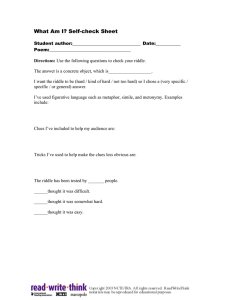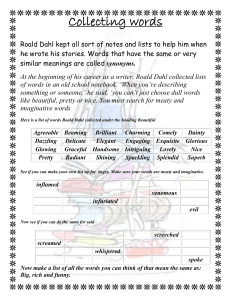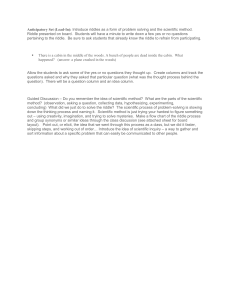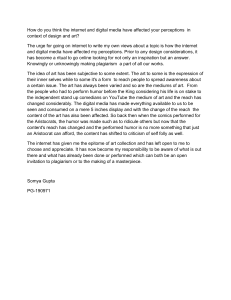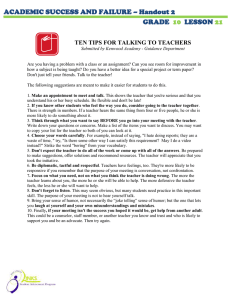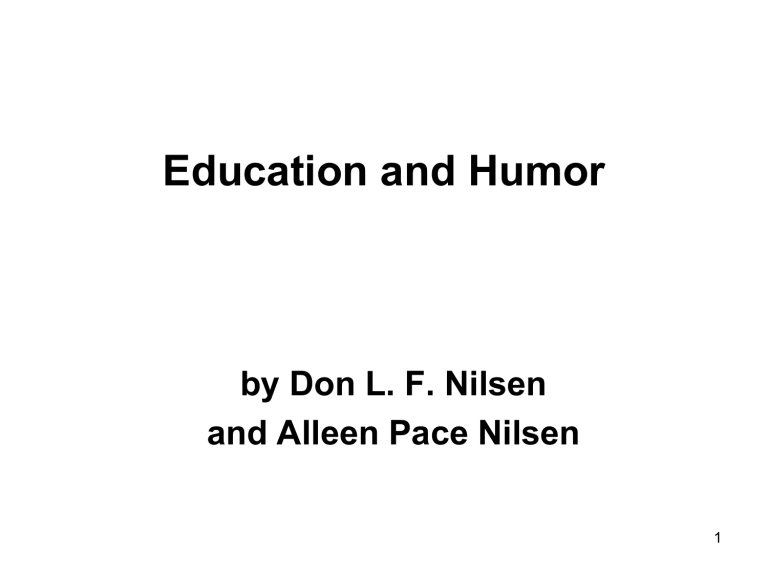
Education and Humor by Don L. F. Nilsen and Alleen Pace Nilsen 1 What is education? Mark Twain gives us the answer: “Education is the path from cocky ignorance to miserable uncertainty.” --Mark Twain 2 The Effects of Education: 3 Education Point of View! 4 Cats and Children Reading 5 Books vs. Texting 6 Children Laughing & Playing Has the fun gone out of school? With all the pressures for higher test scores, adults are struggling to balance the value of play vs. “work.” 7 3-Year Old Jonathan Conducting Beethoven’s 5th Symphony: http://www.youtube.com/watch?v=0REJ-lCGiKU 8 Children’s Laughter 9 10 7-YEAR-OLD PLAYING BEETHOVEN’S “RAGE OVER A LOST PENNY: http://www.youtube.com/watch?v=0CED7cijODg 11 On the side of play and humor people argue that humor: • Fosters analytic, critical, and divergent thinking, • Catches and holds students’ attention, • Increases retention of learned material, • Relieves stress and builds rapport between teachers and students, • Builds team spirit among classmates and smooths potentially rough interactions, • Promotes risk taking while getting shy and slow students involved in activities. 12 Suggestions for having fun while promoting critical and divergent thinking: • In social studies classes, research and report on “ludicrous laws,” such as the one saying that no birds are allowed to defecate in the downtown area. • In science classes, discuss famous bad predictions such as “Heavier-than-air flying machines are impossible.” • In history classes, make WANTED posters for notorious villains. • In music classes, dissect song lyrics and decide which ones are “realistic” vs. which ones are “fantasies.” 13 Dia de Los Libros: 2012 at Arizona State University Don and Alleen Sharing Books 14 Dia de Los Libros: 2013 Don as Lemony Snicket’s Count Olaf 15 Teacher burn-out is a serious issue because if the teacher is stressed, the students will also feel tense. “Survival Rules” cited by John Morreall: 1.Try hard to see the absurdity in difficult situations. 2.Learn to take yourself lightly while taking your work seriously, and 3.Develop your sense of joy and being alive. 16 Good Teachers 17 Bad Teachers 18 19 HUMOR IN EDUCATION • James Gordon, a professor at Brigham Young University says that “when students are having fun, the class time virtually flies by, and the 50 minutes of class seem like a mere 48.” • Sometimes he tells students that the day’s topic is so boring that it fits Mark Twain’s description of “chloroform in print.” • Then he turns away for a minute and reappears in a simple disguise. 20 Putting Excuses in Their Place • Teacher Bill Haggart has noticed that students are really good at thinking of excuses for being absent or for not doing their homework assignments. He accepts only written excuses, and when students bring them to him he has the student place their note on a bulletin board under one of the three following categories: – Helpless, – Hopeless, or – Not in Control of the Body. The activity brings a light touch to the moment, while also making students think twice about whether they want to bring in an excuse. 21 Teachers Miss an Opportunity if They Do Not Make Humorous Books Available SOME FAVORITES: • Roald Dahl • Jack Gantos • Gary Paulsen • J. K. Rowling • Louis Sachar • Shel Silverstein • Lemony Snicket (Daniel Handler) 22 With Older Students, Teachers Can Use Children’s Literature to Teach the Following Literary Concepts • Exaggeration • Anti-Authority Humor • Comedies of Manners • Intellectual Play, including fantasy and wordplay • Parody • Surprise, Incongruity and Scary, Shocking or Verboten References 23 ANTI-AUTHORITY HUMOR Alison Lurie in her Don’t Tell the Grown-Ups: Why Kids Love the Books They Do conjectures that one of the reasons children love the Winnie the Pooh books is that they identify with Christopher Robin, who gets to be an all-powerful, beneficent dictator, or at least the parent figure, for Eeyore, Kanga, Baby Roo, Owl, Piglet, Pooh, Rabbit and Tigger . COMEDIES OF MANNERS One of the most entertaining comedies of manners is Barbara Robinson’s The Best Christmas Pageant Ever in which the worst kids in town, the Herdmans, who have even been known to smoke cigars and to steal stuff from the Sunday School cupboard, are assigned the best parts in the Christmas program. 24 EXAGGERATION The greedy children who get their just desserts in Roald Dahl’s Charlie and the Chocolate Factory make readers feel superior as do the characters in Harry Allard and James Marshall’s The Stupids Have a Ball, The Stupids Step Out, and The Stupids Die. LANGUAGE PLAY One of Judy Blume’s strengths in such books as Are You There, God? It’s Me, Margaret, and Tales of a Fourth Grade Nothing is the witty dialogue of her characters. EMOTIONAL MATURITY Judith Viorst’s Alexander and the Terrible, Horrible, No Good, Very Bad Day makes readers laugh while lending reassurance that people do survive bad days. 25 26 David after Dentist: http://www.youtube.com/watch?v=txqiwrbYGrs 27 SHOCKING AND SURREALISTIC INCONGRUITIES • Maurice Sendak has created such imaginative books as Where the Wild Things Are and In the Night Kitchen. • Sendak’s dream sequences are as creative as the ones in Lewis Carroll’s Alice in Wonderland or Through the Looking Glass, and they are accessible to much younger children. • Neil Gaiman’s The Graveyard Book is an especially intriguing and rich book that both children and adults enjoy. 28 Maurice Sendak 29 Convergent thinking: Not So Good: 30 Divergent Thinking: Much Better: Somebody once said: When everybody is thinking alike…, Then nobody’s thinking. 31 Three-fourths of the time in what used to be called “Grammar School” is spent on language skills. • Walter Redfern, in his Puns says that children play with words much like they do with toys. • Without humor, they would lack practice in the art of thinking—the most complex and powerful survival tool that humans have. 32 Students enjoy drawing cartoons to illustrate different meanings of words. These were modeled after Fred Gwynne’s picture book A Chocolate Moose for Dinner. “Daddy said that he works at the plant.” “Daddy says we have the right to bear arms.” 33 Fred Gwynne & Peggy Parish 34 • The puns and double meanings in nursery rhymes and nonsense verse get children ready for the double meanings of words in the Amelia Bedelia books that you probably remember from grade school. • Amelia is a housemaid who takes everything literally. – When she is told to “put out the lights,” she hangs the light bulbs outside on the clothesline. – When she is told to “dress the chicken,” she puts ruffles and a skirt on it. – When she is told to “draw the drapes,” she gets out a sketch pad and makes a picture. DO YOU REMEMBER ANY OF HER OTHER PUNS? 35 This little boy leaving the public library in Provo, Utah plays a joke by sharing his book with the bronze statue “boy.” 36 37 Young children can be shocked and amused by very simple allusions. • For example, kindergartners’ eyes grow big when they imagine Hans Christian Andersen’s Emperor without his clothes, and they giggle at the sight of holey socks, boxer shorts, garter belts, and bras in Karla Kuskin and Mark Simont’s The Philharmonic Gets Dressed. • For a similar reason, kids love Dave Pilkey’s Captain Underpants books. 38 Karla Kuskin & Dav Pilkey Two Books for Younger Children 39 • Harve and Margot Zemach’s Duffy and the Devil is for slightly older children. • It is a Cornish version of Rumpelstiltskin, in which a frustrated devil turns Squire Lovel’s newly knit clothes to ashes leaving the squire out on the moor naked except for his boots and the hat he clutches in front of his genitals. 40 Suspension of Disbelief: Don and Alleen as Mr. and Mrs. Santa Claus 41 • Roald Dahl is even more shocking in writing about his Big Friendly Giant who thinks “whizzpopping [farting] is a sign of happiness…music to our ears.” • In Dahl’s The Twits, Mr. and Mrs Twit are two of the grossest characters in all of children’s literature. • Mr. Twit is repulsive and hairy and has a disgusting beard that is a smorgasbord of moldy, rotten leftover bits of food stuck to his whiskers. 42 • Mrs. Twit is ugly mainly because she is filled with “ugly thoughts.” • In one scene she drops her glass eye into Mr. Twit’s beer so that when he gets to the bottom of the glass he is amazed to see it staring up at him. • “I told you I was watching you,” cackled Mrs. Twit. “I’ve got eyes everywhere so you better be careful.” 43 David Wiesner’s Art & Max is a clever book set in an Arizona desert. This bulletin board features printed and enlarged copies of student comments. The book can be enjoyed by adults as well as kids. • Wiesner said he created this story about WONDER as a homage to all the artists he loves. • His work illustrates the idea that picture books are really modern “museums between covers.” 44 Art and Max 45 PARODIES ARE INCREASINGLY POPULAR WITH MANY STUDENTS EXPERIENCING THE PARODY BEFORE THEY MEET THE “REAL” STORY • Among the most popular parodies are Jon Scieszka’s The True Story of the 3 Little Pigs, The Frog Prince Continued, The Stinky Cheese Man: And Other Fairly Stupid Tales, and The Math Curse. 46 Jon Scieszka 47 A Shout-Out for Riddles • Adults are always amazed at how young children love the simplest of riddles and tell them over and over again. • They are playing with language, which is their key to adult success, much like small animals play with chasing and fetching and falling all over each other as they get ready for adulthood. 48 Here’s One of Our Favorites • A girl is locked in a room that is empty except for a piano, a wooden table, a saw, and a baseball bat. The door is locked and there are no windows or other openings. How does she get out? • She breaks out with the chicken pox. OR… • She uses the saw to cut the table in half. Since two halves make a whole, she crawls out through the hole. 49 OR… • She plays the piano until she finds the right key. Then she unlocks the door and lets herself out. OR… • She runs around the room until she wears herself out. OR… • She swings the baseball bat three times. It’s three strikes, and she’s out. 50 Here’s another one we like: • What has 18 legs and red spots and catches flies? • A baseball team with the measles. 51 These stages of riddle appreciation come from an article by J. Kenneth Whitt and Norman M. Prentice published in Developmental Psychology . 1. PRE-RIDDLE: What did the big firecracker say to the little firecracker? • You’re too little to pop! 2. HOMONYMIC NEUTRAL RIDDLE: Why is a packed baseball field always cool? • It has a fan in every seat! 52 3. HOMONYMIC SUPERIORITY RIDDLE: Why did the little girl eat bullets?” • She wanted her hair to grow out in bangs! 4. IMPROBABLE RELATIONSHIP RIDDLE: Where can you find roads without cars? • On a map! 5. RIDDLE PARODY: What do squirrels have that no other animal has? • Baby squirrels! 53 A MORE SOPHISTICATED RIDDLE PARODY: • In The Joys of Yiddish, Leo Rosten tells about a father who asks his son, “What is it that hangs on the wall, is green, wet, and whistles?” • When the boy cannot guess, the father responds, “It’s a herring.” 54 • “But” says the son, “a herring doesn’t hang on the wall.” The father responds, “So hang it there.” • “But” says the son, “a herring isn’t green.” The father responds, “So paint it green.” • “But” says the son, “a herring isn’t wet.” The father responds, “It is if it’s freshly painted.” • “But” says the son in exasperation, “A herring doesn’t whistle.” “Right,” said the father, “I just put that in to make it hard.” 55 Points of View about Education 56 The Teacher’s Perspective: TAYLER MALI (WHAT DO TEACHER’S MAKE?): http://www.youtube.com/watch?v=fuBmSbiVXo0&feature=related THE THE IMPOTENCE OF PROOFREEDING (TAYLOR MALI): http://www.youtube.com/watch?v=p_rwB5_3PQc 57 58 The Student Perspective 59 The Teacher’s Perspective 60 Father Guido Sarducci’s Five Minute University: Father Guido Sarducci’s Five Minute University: http://www.youtube.com/watch?v=kO8x8eoU3L4 Periodic Table Song: http://sciencevibe.com/2015/11/08/the-new-periodictable-song/ 61 In conclusion, we will simply end with this picture of two girls having fun in an educational environment. 62 The real Conclusion 63

